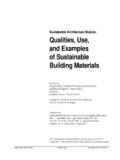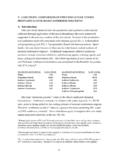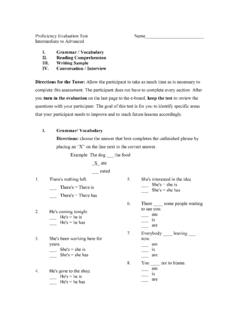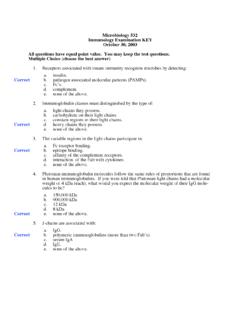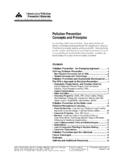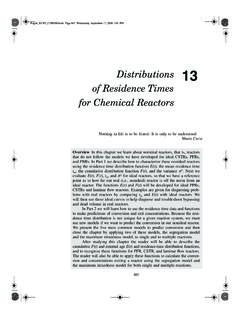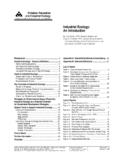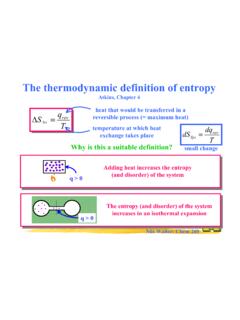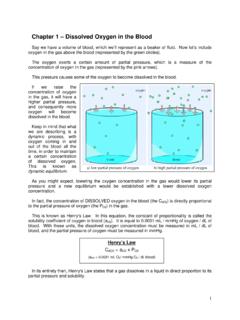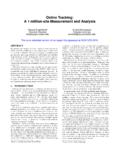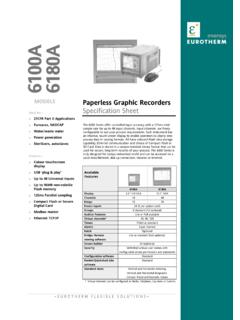Transcription of Catalyst DVD Decay 10 - University of Michigan
1 2006 Pearson Education, rights Elements of Chemical Reaction Engineering,Fourth Edition, by H. Scott Fogler. Catalyst Deactivation In designing fixed and ideal fluidized-bed catalytic reactors, we have assumedup to now that the activity of the Catalyst remains constant throughout the cat-alyst s life. That is, the total concentration of active sites, C t , accessible to thereaction does not change with time. Unfortunately, Mother Nature is not sokind as to allow this behavior to be the case in most industrially significant cat-alytic reactions. One of the most insidious problems in catalysis is the loss ofcatalytic activity that occurs as the reaction takes place on the Catalyst .
2 A widevariety of mechanisms have been proposed by Butt and Petersen, 1 to explainand model Catalyst deactivation adds another level of complexity to sorting out thereaction rate law parameters and pathways. In addition, we need to makeadjustments for the Decay of the catalysts in the design of catalytic adjustment is usually made by a quantitative specification of the Catalyst sactivity, a ( t ). In analyzing reactions over decaying catalysts we divide thereactions into two categories: separable kinetics and nonseparable kinetics . Inseparable kinetics, we separate the rate law and activity:Separable kinetics: a (Past history) (Fresh Catalyst )When the kinetics and activity are separable, it is possible to study catalystdecay and reaction kinetics independently.
3 However, nonseparability,Nonseparable kinetics: (Past history, Fresh Catalyst )must be accounted for by assuming the existence of a nonideal surface or bydescribing deactivation by a mechanism composed of several elementary steps. 2 In this section we shall consider only separable kinetics and define theactivity of the Catalyst at time t , a ( t ), as the ratio of the rate of reaction on acatalyst that has been used for a time t to the rate of reaction on a fresh cata-lyst ( t = 0):(10-92) 1 J. B. Butt and E. E. Petersen, Activation, Deactivation and Poisoning of catalysts (New York: Academic Press, 1988). See also S. Sz pe and O.
4 Levenspiel, Sci. , 23 , 881 894 (1968). 2 D. T. Lynch and G. Emig, Chem. Eng. Sci. , 44 (6), 1275 1280 (1989).r Ar Ar Ar Aat()2r At()2r At 0= () ------------------------=a(t): catalystactivity 1 CatalystDecay DVD 10 2006 Pearson Education, rights Elements of Chemical Reaction Engineering,Fourth Edition, by H. Scott Fogler. 2 Catalyst DecayChap. 10 Because of the Catalyst Decay , the activity decreases with time and a typicalcurve of the activity as a function of time is shown in Figure Equations (10-92) and (3-2), the rate of disappearance of reactantA on a Catalyst that has been utilized for a time t is(10-93)where a ( t ) catalytic activity, time-dependent k ( T ) specific reaction rate, temperature-dependent C i gas-phase concentration of reactants, products, or contaminantThe rate of Catalyst Decay , r d , can be expressed in a rate law analogousto Equation (10-93): r d p [ a ( t )] k d ( T ) h (CA, CB.)
5 , CP)(10-94)where p[a(t)] is some function of the activity, kd is the specific Decay constant,and h(Ci) is the functionality of rd on the reacting species concentrations. Forthe cases presented in this chapter, this functionality either will be independentof concentration ( , h 1) or will be a linear function of species concentra-tion ( , h Ci).The functionality of the activity term, p[a(t)], in the Decay law can takea variety of forms. For example, for a first-order Decay ,p(a) a(10-95)and for a second-order Decay ,p(a) a2(10-96)The particular function, p(a), will vary with the gas catalytic system beingused and the reason or mechanism for catalytic Types of Catalyst DeactivationThere are three categories into which the loss of catalytic activity can tradition-ally be divided.
6 Sintering or aging, fouling or coking, and 10-22 Activity as a function of Aat()kT() fn C A C B C P ,,,() =Reaction rate lawaccounting forcatalyst activitydadt------ Catalyst decayrate law Sintering Fouling Poisoning 2006 Pearson Education, rights Elements of Chemical Reaction Engineering,Fourth Edition, by H. Scott Fogler. Catalyst DecayChap. 10 3 Deactivation by Sintering (Aging). 3 Sintering, also referred to as aging, isthe loss of catalytic activity due to a loss of active surface area resulting fromthe prolonged exposure to high gas-phase temperatures. The active surface areamay be lost either by crystal agglomeration and growth of the metals depositedon the support or by narrowing or closing of the pores inside the Catalyst pel-let.
7 A change in the surface structure may also result from either surfacerecrystallization or the formation or elimination of surface defects (activesites). The reforming of heptane over platinum on alumina is an example ofcatalyst deactivation as a result of 10-23 shows the loss of surface area resulting from the flow of thesolid porous Catalyst support at high temperatures to cause pore closure. Figure10-24 shows the loss of surface area by atomic migration and agglomeration ofsmall metal sites deposited on the surface into a larger site where the interioratoms are not accessible to the reaction. Sintering is usually negligible at tem-peratures below 40% of the melting temperature of the solid.
8 4 Deactivation by sintering may in some cases be a function of the main-stream gas concentration. Although other forms of the sintering Decay ratelaws exist, one of the most commonly used Decay laws is second order withrespect to the present activity: r d k d a 2 (10-97) 3 See G. C. Kuczynski, Ed., Sintering and Catalysis , Vol. 10 of Materials ScienceResearch (New York: Plenum Press, 1975). 4 R. Hughes, Deactivation of catalysts (San Diego: Academic Press, 1984).The Catalyst supportbecomes soft andflows, resulting inpore closure. Figure 10-23 Decay by sintering: pore 10-24 Decay by sintering: agglomeration of deposited metal ViewSide ViewThe atoms movealong the surfaceand 2006 Pearson Education, rights Elements of Chemical Reaction Engineering,Fourth Edition, by H.
9 Scott Fogler. 4 Catalyst DecayChap. 10 Integrating, with a 1 at time t 0, yields(10-98)The amount of sintering is usually measured in terms of the active surface areaof the Catalyst Sa:(10-99)The sintering Decay constant, kd, follows the Arrhenius equation(10-100)The Decay activation energy, Ed, for the reforming of heptane onPt / Al2O3 is on the order of 70 kcal / mol, which is rather high. As mentionedearlier sintering can be reduced by keeping the temperature below to the metal s melting will now stop and consider reactor design for a fluid solid system withdecaying Catalyst . To analyze these reactors, we only add one step to our algo-rithm, that is, determine the Catalyst Decay law.
10 The sequence is shown balanceReaction rate lawDecay rate lawStoichiometryCombine and solveNumerical techniquesExample 10 5 Calculating Conversion with Catalyst Decay in Batch ReactorsThe first-order isomerizationABis being carried out isothermally in a batch reactor on a Catalyst that is decaying asa result of aging. Derive an equation for conversion as a function of equation:( ) rate law:( )at()11kdt+---------------=Sintering: second-order decaySaSa01kdt+---------------=kdkdT0() E d R ------ 1 T 0 -----1 T --- exp=MinimizingsinteringThe algorithm NA0 dXdt ------- 2 r A W =2r Ak at()CA= 2006 Pearson Education, rights Elements of Chemical Reaction Engineering,Fourth Edition, by H.
